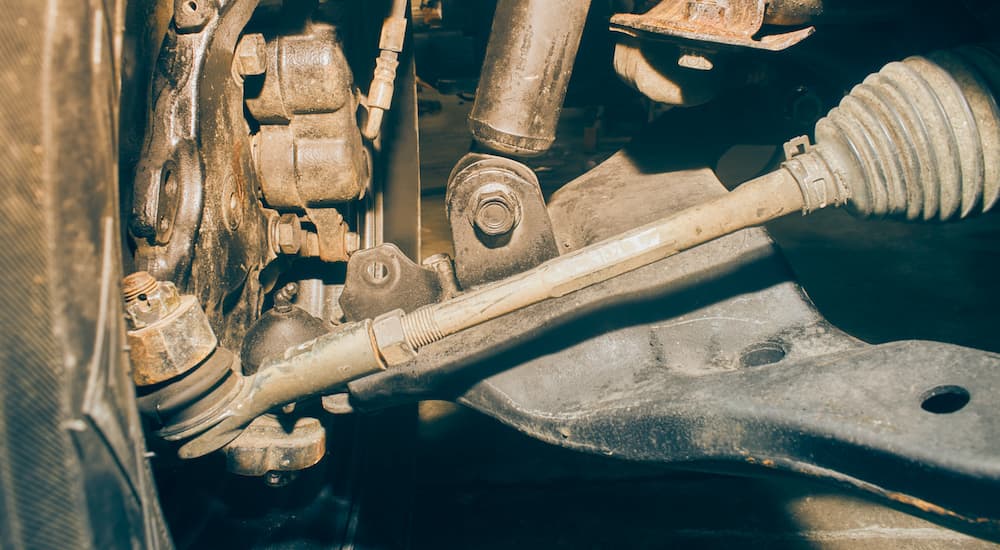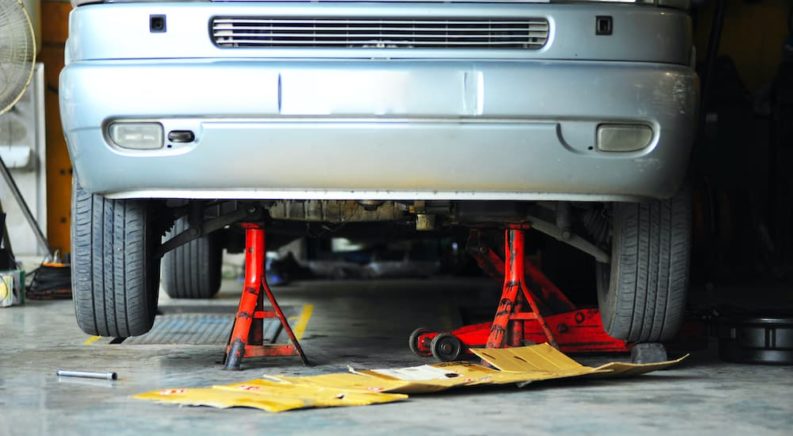Checking and adjusting your car’s alignment at home is not impossible, but it is somewhat complicated and takes some work–that shouldn’t dissuade you from trying it; just be prepared. If you prefer to Google “auto alignment near me” and take your vehicle to a service station, then that’s completely fair, but it is something you might consider tackling. You’re going to need to give yourself a few hours in order to do this properly and make sure you have a setup where your car rests level on the ground to get a true reading when checking your alignment. The good news is that you don’t need any special tools specifically for checking your alignment, though there are some out there that can make things a bit easier.
In order to check your alignment at home, you’re going to need a jack and stands to lift up your car, along with some white spray paint, a tape measure, and a wrench set. You’ll want to have some standard wrenches along with a torque wrench in order to really do things properly. If all this hasn’t scared you off so far, then you’re in good shape, and you’ll find that checking and adjusting some of your car’s alignment at home really isn’t all that difficult.
What Is a Car’s Alignment?
Your car’s alignment refers to the alignment of your wheels, which is measured in three different ways, with reference to each other and the body of your vehicle. In a perfect world, all four of your wheels would be perfectly perpendicular with the ground and parallel with each other, forming an ideal shape of harmonious geometry. We don’t live in that world, however, so the wheels on our cars are actually angled in different ways we can measure. The three types of alignment are:
- Toe – This is the angle of your wheels when viewed from overhead. If you stand up and look down, picture your feet as the wheels of your car; angle your feet with the toes out, and you have negative toe-out alignment, then angle your feet in, and you’ll see positive toe-in alignment.
- Camber – This is the alignment of your wheels when you look at them from the front-end of your car, in relation to how perpendicular they are to the road. Perfectly straight would be 0-degree; positive camber is when the tops of the wheels angle out away from your car, while negative camber is when they angle inward toward your vehicle.
- Caster – This one is a little trickier, and you need to imagine a line drawn through the pivot points on your steering system when viewed from the side. A 0-degree caster would be perfectly vertical. Negative caster means the line of your wheel’s pivot points leans forward, while positive caster means it’s angled backward.
If you take your car to a shop for alignment service, then they’ll measure all three types and check to ensure they’re within spec as recommended by the manufacturer. When checking your alignment at home, you’ll need to look up the manufacturer specs for your model and year to see what it should be.
Why Are My Tires Wearing Quickly/Unevenly?
Quick or uneven wear to your tire treads often means you have an issue with your vehicle’s alignment causing the tires not to ride as perfectly as they should. If you notice a saw-tooth pattern on your tires, then this often indicates a problem with your wheel’s toe alignment, while more beveled wear on tires can mean your camber alignment is off. Keep in mind that you should also rotate your tires on a manufacturer-recommended schedule to ensure even wear across all of them.
Why Is My Car Shaking so Much?
Excessive shaking when you’re driving is a common sign of either an alignment issue or some other problem with your steering and suspension. When your alignment is off, you’ll frequently feel like you’re fighting against your car’s steering to drive straight or when making a turn. Your car’s suspension is there to help absorb a lot of the roughness from the road when you drive, so excessive shaking might also mean you have worn shocks or another suspension issue.

How do I Check My Alignment?
The easiest type of alignment to check and adjust at home is the toe alignment, particularly if you have a front-wheel drive car. To start, you need to park your vehicle on level ground so that your wheels are as even as they can possibly be. Make sure you adjust the steering wheel so that it’s centered–you might already see something is off if your alignment is really a mess.
Now, use a jack to lift your front tires, and jack stands to secure your vehicle to keep your front wheels lifted–you’re going to need to be able to spin them freely. Set a can of spray paint on the ground just in front of one of your front tires so that it’s level, and then paint a stripe onto the surface of the tire as you spin the tire in order to make a single, even stripe on the tread. After you have this stripe, you need a more precise line, so hold a nail or something similarly sharp in place while you spin the tire lightly against it in order to scrape an even line out of the paint–you’re going to use this for measuring.
Once you’ve done this one, repeat the process on the other front wheel–you don’t have to worry about getting the stripe or line in the exact same spot on the second tire. We’re not looking for a specific measurement but a comparison between the front of the tire and the rear of it. Once you have your second inscribed line in paint, use a tape measure to measure the distance between the lines on the front of the tires. Make sure the measuring tape is level with the floor, and do your best to hold it mid-way up on the tires for the most accurate measurement.
Now you’re going to measure the distance between the lines on the back of the same tires using a level tape measure at the same height as before. When you compare the distances that you just measured, you’ll get a measurement of your toe alignment in inches. If the front distance is greater, then you have toe-out alignment; a greater back distance means your wheels are toe-in. Your vehicle’s manufacturer will indicate what the alignment should be – it’s probably not perfectly straight. Most cars have a slight toe-in alignment that adjusts for the way your wheels shift when you’re driving and putting force on them.
How Do I Adjust the Alignment?
If your toe alignment isn’t where it should be, you can use a wrench to loosen the tie-rod adjuster sleeves on your wheels. Then you can adjust the tie-rods on each side of your suspension to alter the toe alignment. Once you think you have it where it should be, then safely roll your vehicle back and forth several feet a few times in order to have the adjustment to the alignment take effect. After you do this, park your car again, lift it up, and measure the toe alignment using the lines on the front and rear of your tires again to see if it’s where it should be. This might take a few tries to get it right, but you can do it. Finally, use a torque wrench to tighten the tie rod adjuster sleeve to the factory specs from your car’s manufacturer, and you’re all done.

What About Other Alignments?
Unfortunately, adjusting the camber and canter on your vehicle is much more difficult than the toe. You can measure your camber alignment if you think something is off by parking your car on level ground; use a straight edge and an angle-finder to check if your camber is off. Most cars these days have slight negative camber to improve stability, but if it’s beyond factory spec, then that’s a problem. The bigger problem, however, is that you can’t usually adjust the camber and caster easily, and an alignment problem often means a part is damaged or worn and needs to be replaced. While diagnosing and fixing these issues is generally simple enough, it does require some extra knowledge and tools, making it more difficult to do at home.

